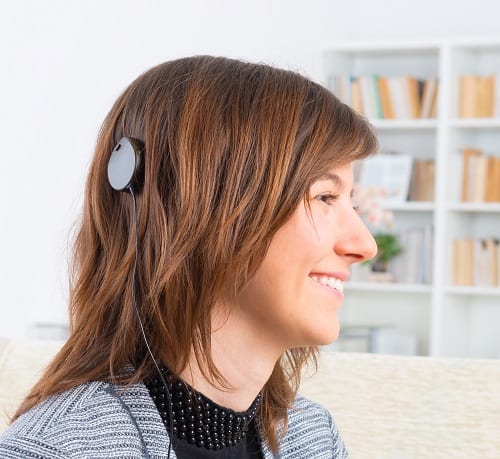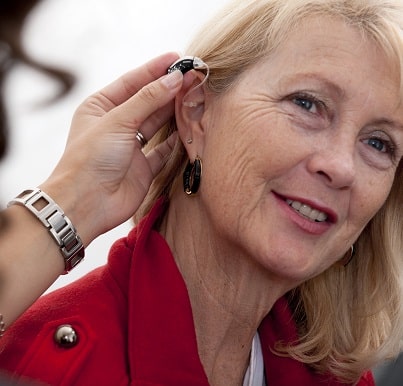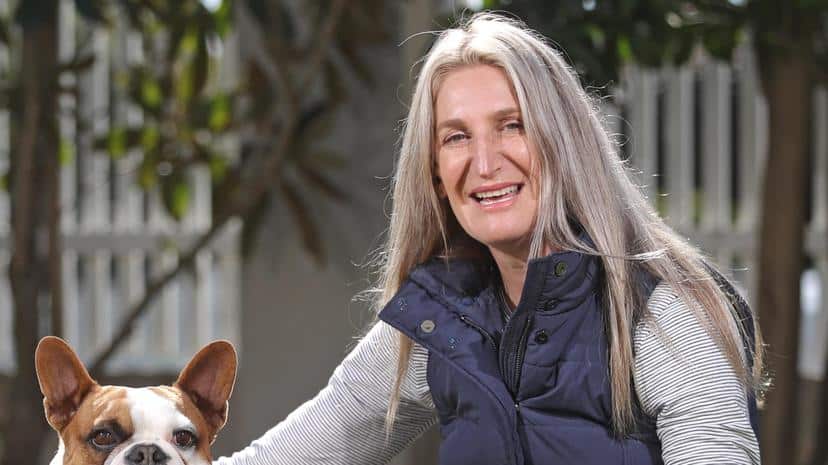Australia has been at the forefront of innovation in cochlear implants since 1975
Professor Graeme Clark and his team implanted the first cochlear implant with a multiple-channel electrode. Independently, a team led by Drs Ingeborg and Irwin Hochmair in Austria also developed and implanted their first patient with a multi-channel cochlear implant in 1975.
Both of these electrodes were significant advances in the work of others in Europe and the USA since the 1950s (DeSaSouza, 2022).
Cochlear implants were approved for use by the FDA in 1985, and it is estimated that now over 1 million people have benefited from a cochlear implant (Zeng, 2022). Since these first prototypes, where the user had to carry a large box of electronics, cochlear implants have seen many technological advances and innovations. These include miniaturisation of the electronics, more electrodes in the array, better coding of speech, improvements in user comfort (especially for long periods), and suitability for MRIs. Off-the-ear processors allow the sound processor to be taken off the ear for activities like sports.
The work of Professor Clark led to the formation of Cochlear Ltd in Sydney in 1983. Professors Ingebor and Erwin Hochmair formed the MED-EL company in 1989 headquartered in Innsbruck, Austria. Both companies are still recognised as world leaders in cochlear implants. The third largest implant manufacturer is Advanced Bionics in Switzerland.
Today, cochlear implants are the gold standard treatment option for people with severe to profound hearing loss who wish to hear. Improvements in cochlear implant technology and surgical techniques have also resulted in cochlear implants being considered for people with moderately severe hearing loss, people with severe hearing loss in just one ear (single-sided deafness), and people with steeply sloping hearing loss. They can significantly improve hearing and quality of life for children and adults living with hearing impairment.

Cochlear implant electrode improvements
The shape and style of the tiny electrode inserted into the cochlea has evolved to improve the preservation of any hearing that an individual may still have (residual hearing). The electrode body is now thinner, which reduces surgery time and post-operative discomfort, and is stronger to withstand the demands of everyday life and activities.
Current research is investigating how electrodes can slowly release specific drugs to stabilise the health of cells impacted by cochlear implant surgery.
Cochlear implant sound processor, size and capability innovations
Patients with cochlear implants benefit from cutting-edge sound processing technology that analyses the surrounding noise and automatically modifies the processor’s settings for optimum hearing. Advances in the programming of sound processing algorithms have improved the user’s abilities to hear sounds other than speech – such as music. There are also special programmes for those using tonal languages like Chinese.
Ongoing technological advancements led to smaller, lower-profile cochlear implant devices and sound processors that fit more comfortably over the ear. Although smaller devices might not always result in better hearing outcomes, they can be more comfortable to wear which may be an important issue.
Some of the most recent processors are all-in-one devices. They are held in place over the internal device’s headpiece by a magnet, allowing them to sit entirely off the ear. Sound processors are available in various colours to match skin and hair tones. Additionally, recent cochlear implants have alternative battery charging options and longer battery life.
The most recent sound processors also boast excellent water resistance ratings, translating into sweat-proof and splash-proof characteristics. These features benefit individuals who like water sports or live in high-humidity locations. Additionally, waterproof accessories have been developed to allow users to swim with their sound processor in place.
Modern implants are now suitable for medical imaging; in the past, parts of the implant had to be removed if an MRI was required.
Modern-day cochlear implants allow users to stay connected to their electronic devices like never before. Direct streaming capabilities are often available with compatible Apple or Android devices thanks to the Bluetooth technology available in more recent cochlear implant processors. This lets individual users listen to audio input, including music and phone calls, from their smart device directly to their sound processor without the need for wires or an intermediate “streaming” device.
Bluetooth functionality within the sound processor has increased users’ convenience of managing and accessing audiological support from the comfort of their home or workplace for some devices.
To make cochlear implants an even more successful therapeutic option, millions of dollars are invested in research and development each year. Research continues to make the devices smaller, quicker, better connected, improve hearing outcomes, and better protect the neuronal structures of the inner ear. Researchers are spending time on ways to predict outcomes better (Shafieibavania, 2022), and if cochlear implants reduce the effects of tinnitus, much like hearing aids are used nowadays (Assouly, 2022).
Ear Science Institute Australia is excited to keep up with the latest technological advancements for Cochlear Implants. If you’d like to be part of our cochlear implant research or find out of a cochlear implant might be right for you, contact us today to find out more.
If traditional hearing aids haven’t worked for you and you are looking into a cochlear implant contact us today with any questions.
References:
DeSaSouza S. A historical review of the development of cochlear implants. In: DeSaSouza S (eds) Cochlear Implants. Springer, Singapore. 2022. https://doi.org/10.1007/978-981-19-0452-3_1
Zeng F-G. Celebrating the one-millionth cochlear implant. JASA Express Letters 2, 077201; 2022. https://doi.org/10.1121/10.0012825
Shafieibavania E, Kiral I, Goudey B, Zhonga P, Jimeno-Yepes A, Swan A, Gambhir M, Buechner A, Kludt E, Eikelboom RH, Sucher C, Gifford RH, Rottier R, Plant K, Anjomshoaa H. Predictive models for cochlear implant outcomes: performance, generalizability, and the impact of cohort size. Trends in Hearing. 25; 2021. https://doi.org/10.1177/23312165211066174
Assouly K, Smit AL, Eikelboom RH, Sucher C, Atlas MD, Stokroos R, Stegeman I. Analysis of a cochlear implant database: changes in tinnitus distress after cochlear implantation. Trends in Hearing. 26; 2022. https://doi.org/10.1177/23312165221128431






